Your cart is currently empty!

Water Treatment Plants and Water ATMs
Water treatment plants reflect a sustainable solution for clean water access. In many parts of Kenya, access to clean and safe water is a challenge that has existed for long. Nevertheless, with the current technological trends and advancements in automation, innovative solutions have emerged. One such solution is the emergence of water ATMs in the country. It’s not surprising to find water refill bottles in the villages – every corner in the country. This is enough proof of the rise in the number of households seeking and already consuming clean water. This dream has been realized through water ATMs and efficient water treatment plants.
Water ATMS
To a greater extent, water ATMs came to bridge the gap in claen water accessibility. More importantly, water ATMs have been embraced as a new avenue of minting money as many entrepreneurs set up water refilling stations. In almost every urban center in kenya, there are several water atms or water refilling stations. For consumers, all that is needed is an empty bottle and you will take home clean and safe water. On the other hand, from a business perspective, you have a water treatment plant for your refilling station.
Water atms, like in the case of milk and cooking oil ATMs, are self-service kiosks. Well, it’s likely you will find an agent in the water refilling station but not always. Users or rather clients are at liberty to access clean water by way of inserting coins or making mobile payments. Read more about water ATM Business.
Now let’s look at the role played by water treatment plants.
Water Treatment Plants in Water ATMs
Water purification facilities are essential to the operation of Water ATMs. Water treatment facilities act as the system’s skeleton in addition to assuring a constant supply of clean water. In other words, they supply and ensure that water that has been treated satisfies regulatory criteria and is safe to drink. Impurities, pollutants, and pathogens are three dangerous components of water that must be removed during the various phases of the water treatment process in these facilities. When this occurs, the source water is transformed into drinkable water.
Key Processes in Water Treatment Plants
- Pre-Treatment: Processes are used to prepare raw water from a variety of sources, including rivers, lakes, and groundwater. These might involve adding chemicals for coagulation and flocculation, screening to remove big debris, sedimentation to settle suspended particles, etc.
- Filtration: Following pre-treatment, the water is sent through filters to get rid of any leftover pollutants and finer suspended particles. Rapid sand filtration or membrane filtration methods like reverse osmosis (RO) or ultrafiltration (UF) are common filtration procedures.
- Disinfection: This essential procedure ensures the elimination of dangerous germs. Chlorination, UV radiation, and ozonation are common disinfection techniques that efficiently eliminate or inactivate bacteria, viruses, and other pathogens that are present in the water.
- Post-Treatment and Monitoring: To improve the quality of the water after disinfection, water treatment facilities may alter the pH, add the required minerals, or use post-treatment procedures. Before treated water is given to Water ATMs and distribution networks, it is regularly tested and monitored to make sure that safety criteria are being met.
Advantages of Water ATMs to the communities
Improved Access: Water ATMs are located in places where there aren’t enough clean water sources, making it simpler for people to get access to clean water without having to drive far.
Cost-effective: By offering water at reasonable pricing, these automated systems make it more accessible to people who are struggling financially.
24/7 Accessibility: Water ATMs are always open, assuring a steady supply of clean water even in times of need or after regular business hours.
Reduced Dependence on Plastic Bottles: Water ATMs work to lessen the environmental damage caused by single-use plastic bottles by encouraging the use of reusable containers.
Advantages of Water ATMs to the business owners
Investors in water ATMs take satisfaction in the following aspects of the cutting-edge venture:
Profitability of the water ATM industry: Operating a water ATM business can be successful. You as the business owner can create a reliable income stream by offering hygienic drinking water at reasonable costs. The demand for Water ATMs is set to rise as more people realize how important it is to drink pure water, providing business owners with a lucrative opportunity.
Low Cost of Operation: Water ATMs running expenses are comparatively inexpensive. After making the initial investment in the ATM machine and water treatment equipment, the key recurring costs are maintenance, filling up the water storage tanks, and routine equipment servicing. With effective management, business owners can increase their earnings while maintaining
Scalability and Flexibility: Water ATMs give business owners both geographic and scale flexibility. Regardless of the setting, urban neighborhoods or rural communities, clean and safe water is needed all the time. Thus, the water treatment machines can be deployed anywhere. Entrepreneurs can decide how many ATMs to run, enabling scalability based on demand in various locations.
Conclusion
A sustainable solution to the problem of clean water accessibility around the world is provided by water treatment facilities and water ATMs combined. Communities can benefit from better health outcomes, a decrease in waterborne infections, and a more ecologically friendly attitude to water usage by establishing efficient water treatment systems and delivering purified water through handy ATMs. To ensure that everyone has access to clean water, governments, organizations, and communities must continue to invest in these cutting-edge technologies and work together.
Leave a Reply